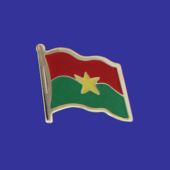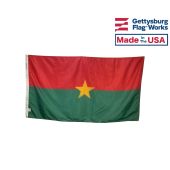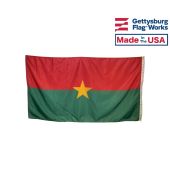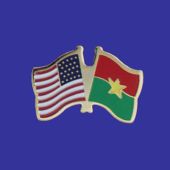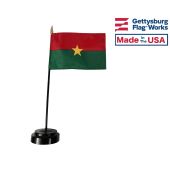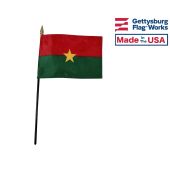Burkina Faso Flags
Flag of Burkina Faso
The Burkina Faso flag is a symbol of both the nation of Burkina Faso and of the nation's solidarity with the other countries of Africa. It is one of only two flags to represent the country since it gained its independence from European influence during the second half of the 20th century. The current flag of Burkina Faso came into use relatively recently, but it includes design features that are part of a tradition that stretches back for many decades and predates the nation's independence.
The flag of Burkina Faso is formed by two equal horizontal bands of red (top) and green, with a yellow five-pointed star resting in the center. The flag was adopted on 4 August 1984. The flag is coloured in the popular Pan-African colours of the Ethiopian flag, reflecting both a break with the country’s colonial past and its unity with other African ex-colonies. The red is also said to symbolize the revolution and the green the abundance of agricultural and natural riches. The yellow star placed over the red and green stripes is the guiding light of the revolution. The flag was adopted following the coup of 1983 which brought Thomas Sankara to power.
- Capital of Burkina Faso: Ouagadougou
- Area of Burkina Faso: 273,800 sq. km
- Languages used in Burkina Faso: French (official), native African languages
- Religions in Burkina Faso: Indigenous beliefs, Muslim, Christian
Colors and Symbolism of the Burkina Faso Flag
The Burkina Faso flag is a horizontal bicolor of red and green that is displayed in a 2:3 ratio. The center of the flag displays a yellow star with five points. The three colors came from the flag of Ethiopia, which has been a symbol of African unity and independence from European influence for many years. Burkina Faso's use of the colors for its flags is a sign of solidarity with the African people and of the nation's dedication to independence in the modern era. The red portion of the flag honors the country's revolution and its early leaders, while the green portion of the flag represents the nation's agricultural sector and its natural resources. The gold star represents the guiding influence of the revolution's ideals over the country. The star can also be found on the flags of many other African nations, so it further emphasizes the link between Burkina Faso and the rest of the continent.
History of the Flag of Burkina Faso
The modern flag of Burkina Faso is the second flag to represent the country in the years following the colonial period. The nation was known as Upper Volta when it first gained its independence, and it used a different flag while it was known by that name. The original fag was a horizontal tricolor of black, white, and red. The three colors were chosen to represent the three rivers that ran through the country, which were known as the Black, White, and Red Volta rivers. Upper Volta's flag used the same design as the flag of the German Empire, but the similarity was a coincidence.
Burkina Faso adopted its current flag in 1984, at the same time that it adopted its modern name. The flag came into use after a coup led by Thomas Sankara overthrew the nation's previous government. The flag was not replaced after Thomas Sankara's death, and it has been used ever since it was first adopted without any changes.
